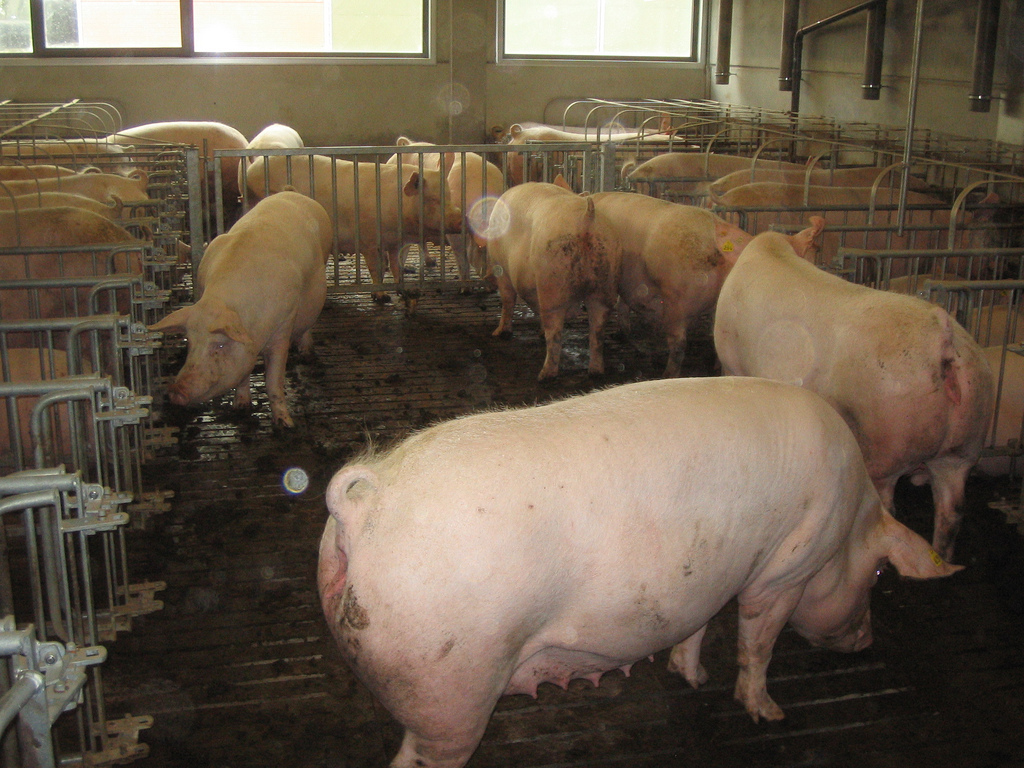World News
Farmers move pregnant pigs to bigger pens to sate consumers, but find change not cheap or easy
FAIR OAKS, Ind.—Pigs cluster around a food stall like Black Friday shoppers waiting for the store to open. One pushes impatiently against the locked door with her snout, waiting for the sow inside to finish eating so she can take her turn.
After about 10 minutes, the sated sow sidles out the front gate and rejoins about 80 other pregnant pigs in a large pen surrounding the food stall.
The hungry pig enters the stall through the now-open back door, and food flows in from a computer-controlled dispenser.
The big pens and electronic feeding systems at Fair Oaks Farms in Indiana could be the future of the pork industry as consumers pressure farmers to move pregnant pigs out of individual stalls too narrow for the animals to turn around. The switch from gestation stalls is not as simple as many consumers believe, however. It’s expensive, there are debates over pen designs and it takes time to train pigs to use feeders and other equipment. In short, farmers are spending millions of dollars with no certainty yet that the changes are best for the animals.
Most bacon, ham and chops come from hogs that never spend time in the narrow breeding stalls, though the hogs’ mothers almost certainly did—if only a few days for insemination. More than four out of five sows in the U.S. remain in the stalls after they become pregnant, according to a 2012 study done for the National Pork Producers Council.
But a growing number are being moved into group pens as industry giants like Smithfield Foods and Cargill try to protect their brands from criticism by animal rights activists. Other major pork processors who have not required farms to convert are seeing some do so because image-conscious buyers, such as McDonald’s, Oscar Mayer and Safeway, have called for an end to gestation crates.
Americans pig out on pork, eating an average of 45 pounds per person each year. Sales were worth more than $97 billion in 2011, according to industry groups.
Most of the hogs bought by Indiana Packers Corp., a major meatpacker, come from open-pen gestation and have for several years, President Gary Jacobson said. The switch has been hastened by laws in Michigan and Ohio requiring farmers to phase out gestation stalls by certain dates, but Jacobson said it also makes business sense.
“Given the controversy with the gestation crates, we would encourage people to look at the alternatives for that,” he said.
The alternatives aren’t cheap. Malcolm DeKryger, a partner in Fair Oaks’ hog farm, said a 2,400-pig barn with gestation stalls typically costs about $1.8 million. The feeding system, other equipment and extra space required for group pens can push the cost to $2.5 million. He and his partner spent even more because their farm, about 1.5 hours south of Chicago, has observation areas for tourists.
DeKryger isn’t entirely sold on group pens, which remind him of the farms where he worked as a teenager.
“We would throw feed over the gate, and the sows would all go crazy … one sow would eat three times as much, and others would get gypped or didn’t eat enough. And that system is happily gone,” he said.
Gestation stalls became standard in the 1980s and enabled farmers to feed each sow individually. The stalls also prevented pecking-order fights and injuries caused by sows mounting each other.
Better technology addresses some of those problems in group pens. The sows at Fair Oaks go through a monthlong boot camp at about 6 months old to learn to use electronic feeders that ensure each one eats the right amount.
A scanner reads the sow’s ear tag when she enters the stall, and computer-controlled equipment dispenses the recommended portion, usually about 5 pounds. When the sow leaves, the door can open either to the right for veterinary care or left to the group pen.
Farm workers are testing other ways to reduce conflict that can injure smaller sows and cause them to miscarry. For example, pigs in groups scrum to establish a pecking order. Fair Oaks workers aim to move sows into 80-pig pens all in one day so the order can be set and peace established. Later additions would cause new fights.
An alternative is to place sows in groups too big for them to notice when a new animal enters.
DeKryger said it’s too soon to tell which method works best in reducing fights. And no system is perfect.
On a recent day, a bigger sow muscled her way into line at the feeder like a mean girl in middle school. A sow in another pen mounted a smaller one, leaving it with a limp. Yet another sow got its foot caught under rail, squealing and thrashing about until a worker freed it.
A foot or leg injury can mean death to a hog, and studies have shown such injuries are slightly more common in group pens than individual stalls because the animals move more.
“We can’t fix a broken bone,” DeKryger explained. “If they dislocate a hip, we have to euthanize.”
He has five other farms in Indiana, most with gestation stalls, and said he’s not sure what he would build next. Group housing requires more space and therefore a bigger investment, and thus far, he’s seen no payoff in healthier animals or profits.
But, he said, “if my ultimate customer says this is what I know and want—and that’s a very dicey observation … is it smart for me to say, eh, you aren’t qualified to know what I do, so I’m just going to tell you to take a hike?”






















